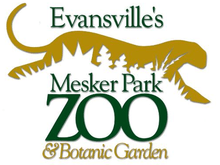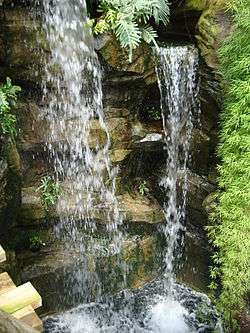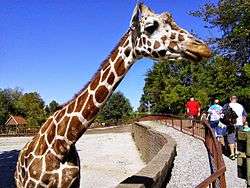Mesker Park Zoo and Botanic Garden
The Mesker Park Zoo and Botanic Garden is a zoo that opened in 1928 in Evansville, Indiana, United States. It is located in Mesker Park on Evansville's northwest side and is run by the City of Evansville.
 | |
Zoo entrance | |
| Date opened | 1928[1] |
|---|---|
| Location | Evansville, Indiana, United States |
| Coordinates | 37.9971°N 87.6016°W |
| Land area | 50 acres (20 ha)[1] |
| No. of animals | 700+[1] |
| No. of species | 200 |
| Memberships | AZA[2] |
| Major exhibits | African Rift, African Panorama, Amazonia, Australia, North America, and South America |
| Website | www |
The Mesker Park Zoo and Botanic Garden is accredited by the Association of Zoos and Aquariums.
History
The zoo was founded in 1928 by Gilmour Haynie and other business leaders. Karl Kae Knecht, a local cartoonist for the Evansville Courier & Press, helped popularize the idea of a zoo. It initially opened with two lion cubs, some antelope, and an elephant.[3]
In 2008 the zoo finished a major expansion including the $15 million tropical rainforest exhibit and a new entry complex.[4] The new exhibit was credited with drawing more than 38,000 visitors in its first month.[5] One of two existing lakes in the zoo was filled in to make the exhibit, which added more than 150 animals to the zoo.[6]
In 2017, the zoo added Engelbrecht Carousel, with an adjacent bird aviary added in 2018. A carousel used to be at the zoo. The total cost for this project is $3 million.[7]
Currently in the design stage as of 2018, is a new outdoor penguin exhibit.[7][8] (As of September 2019 the penguin exhibit is slated to open in 2021 per information board inside the zoo.) Additionally, the zoo plans to revamp the African Rift area when funding becomes available.[7]
Exhibits

Mesker Park was one of the first zoos in the United States to use a moat system to display animals in more natural exhibits.[3]

Amazonia
Amazonia is a Central/South American focused rainforest exhibit that opened in 2008. While there are large structures within the exhibit designed to look like vegetation, many of the plants seen within are in fact living plants, maintained by the zoo's grounds crew. As such, the exhibit grows and changes in time as plants are added and occasionally trimmed so as to not completely block out the sunlight. The exhibit added more than 150 animals to the zoo and is currently highlighted by jaguars, Baird's tapir, capybara, keel-billed toucan, bats, black howler monkeys, squirrel monkeys, prehensile-tailed porcupines, Arrau turtles, Cuvier's dwarf caiman, and several fish species from the Amazonian River system. The open spaces of the exhibit also function as a free-flight bird aviary, and house over ten species of birds.
North America
North America includes a large Mexican gray wolf enclosure, as well as prairie dogs, and several birds of prey.[9]
Discovery Center
The Discovery Center is an indoor/outdoor exhibit that focuses on conservation, education, and endangered species. It also houses the zoo's education department and many of the animal used in educational programs, though some of these might not always be visible to the public. This exhibit contains Francois' langur, red pandas, clouded leopard, hyacinth macaw, and several smaller reptile enclosures.[9] Of particular note is the Hellbender exhibit, where the zoo holds juvenile eastern hellbenders as part of a statewide conservation program in association with Purdue University and the Indiana Department of Natural Resources.[10]
Lemur Forest
Lemur Forest was opened in 1999 to house the zoo's lemurs. It currently holds three species: ring-tailed lemurs, red ruffed lemurs and Coquerel's sifaka.[11]

African Rift
The African Rift exhibit includes reticulated giraffes, Grant's zebras, sitatunga, and white storks in a large open areas.[9] In July 2018, the zoo welcomed a new 10-month-old giraffe named Clementine.[12]
Kley Building
The Kley Building was built in the 1950s and houses several exhibits. The upper floor contains a nocturnal exhibit, a reptile exhibit hall featuring rhinoceros iguana and Komodo dragon, and an exhibit hall used for traveling exhibits or special events. The lower floor contains the indoor portion of the zoo's Indian rhinoceros exhibit.[9] This floor was once home to Bunny, an asian elephant and the world's oldest living hippopotamus in captivity, Donna, who was euthanized at the age of 60 in 2012, because of her failing health.[13]
Asia & Australia
This area reproduces habitats for Asian and Australian animals. It includes the outdoor exhibits for the zoo's Indian rhinoceros, as well as Bactrian camels, sarus crane, barasingha, Amur tigers, Malayan sun bear, takin, kookaburra, and emus.[9]
Children's Enchanted Forest
This exhibit is geared towards children and contains several playground elements and a seasonal petting zoo in addition to traditional zoo exhibits. It is home to North American river otters colobus monkeys, binturong, DeBrazza's monkeys, African crested porcupine, and macaws.[9] Nearby are the Engelbrecht Carousel[7] a budgie aviary, a gibbon exhibit and seasonal exhibits for tortoises.
Lake Victoria
Lake Victoria is home to wild water birds and turtles. Visitors can walk all the way around this lake, or rent paddle boats to go out on the lake. This is the largest lake in the zoo, and is the feature around which the zoo was built.[9]
African Panorama
African Panorama is a set of enclosures built around a large open African savanna exhibit, with overlooks for visitors. The main exhibit features Abyssinian ground-hornbills, ostriches, kudu, African crowned cranes, and springbok.[9][14] Smaller exhibits feature a giant anteater,[15] mara, and stanley crane.
Botanical features
In addition to the live plants inside Amazonia, the grounds of the Mesker Park Zoo feature several gardens designed for guest experience, as well as plants specifically cultivated for zoo animal consumption. Zookeepers harvest these plants throughout the year as part of their animals' diets.
Each year, in February, a variety of orchids line the Amazonia exhibit as part of the Orchid Escape event. There is also a plant sale fundraiser in the spring, where guests can purchase young specimens of plants seen throughout the zoo.
Additional attractions and programs
In addition to the new carousel, the zoo also contains a playground, cafe, gift shop and tram. The zoo also provides a wide variety of programming, from birthday parties to summer camps to outreach programs, as well as teen and adult volunteer opportunities.
Conservation
Many of the animals at the zoo are part of breeding programs organized by the AZA and the zoo is therefore recommended to breed (or not breed) its animals in accordance with those programs. Some recent births include Francois' langur, sitatunga, takin, African crested porcupine, colobus monkey, and lesser tenrec.
Mesker Park Zoo houses a pair of Mexican gray wolves, a critically endangered animal, and works with United States Fish and Wildlife Service as part of their recovery plan for this species.[16]
The zoo is also involved in eastern hellbender conservation,[16] and is partnered with Purdue University and Indiana's Department of Natural Resources in their efforts to repopulate this subspecies of salamander. The zoo currently has a public display of tanks holding juvenile hellbenders, which will be returned to their habitat once they have reached a certain, less predated size, and an off-display adult stream containing several adult salamanders that might hopefully breed.
References
- "Mesker Park Zoo & Botanic Gardens". meskerparkzoo.com. Mesker Park Zoo & Botanic Gardens. Retrieved 21 September 2010.
- "List of Accredited Zoos and Aquariums". aza.org. Association of Zoos and Aquariums. Retrieved 20 September 2010.
- "The Beginnings of Evansville's Mesker Park Zoo". The Boneyard. Retrieved 24 December 2006.
- "Amazonia opens with a roar". Evansville Courier & Press. Retrieved 16 September 2008.
- "Amazonia helps zoo draw more than 38,000 visitors in exhibit's first month". Evansville Courier & Press. Retrieved 14 October 2008.
- "It'll be a jungle out there". Evansville Courier & Press. Retrieved 24 December 2006.
- "Mesker Park Zoo Holds Soft Opening for Carousel – 44News | Evansville, IN". 44News | Evansville, IN. 24 June 2017. Retrieved 11 September 2018.
- "Evansville 2019 City Budget Proposals – 44News | Evansville, IN". 44News | Evansville, IN. 27 August 2018. Retrieved 11 September 2018.
- "Mesker Park Zoo & Botanic Gardens" (PDF). meskerparkzoo.com. Mesker Park Zoo & Botanic Gardens. Archived from the original (PDF) on 14 July 2011. Retrieved 21 September 2010.
- "Mesker Park Zoo – Current Conservation Efforts". Retrieved 30 January 2019.
- "Zoo History". meskerparkzoo.com. Mesker Park Zoo & Botanic Gardens. Archived from the original on 30 January 2011. Retrieved 21 September 2010.
- "Meet Clementine: Mesker Park Zoo's Newest Addition – 44News | Evansville, IN". 44News | Evansville, IN. 28 July 2018. Retrieved 11 September 2018.
- Jessica Wray. "Zoo officials: Donna the hippo will be euthanized Wednesday". Evansville Courier & Press. Retrieved 1 August 2012.
- "Tour the Zoo". meskerparkzoo.com. Mesker Park Zoo & Botanic Gardens. Archived from the original on 30 January 2011. Retrieved 21 September 2010.
- "Evansville Courier & Press". Evansville Courier & Press. Retrieved 30 January 2019.
- "Mesker Park Zoo – Current Conservation Efforts". Retrieved 31 January 2019.